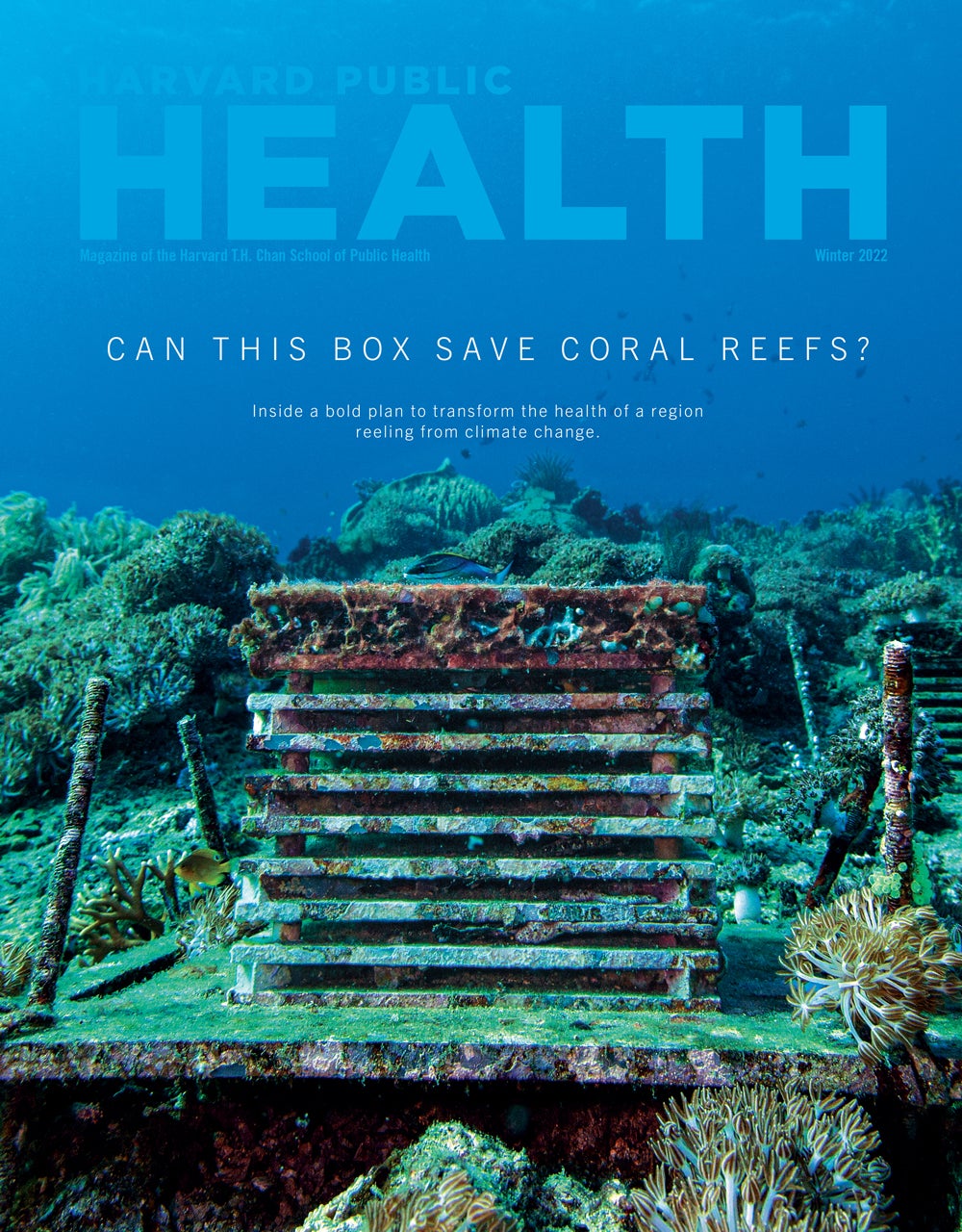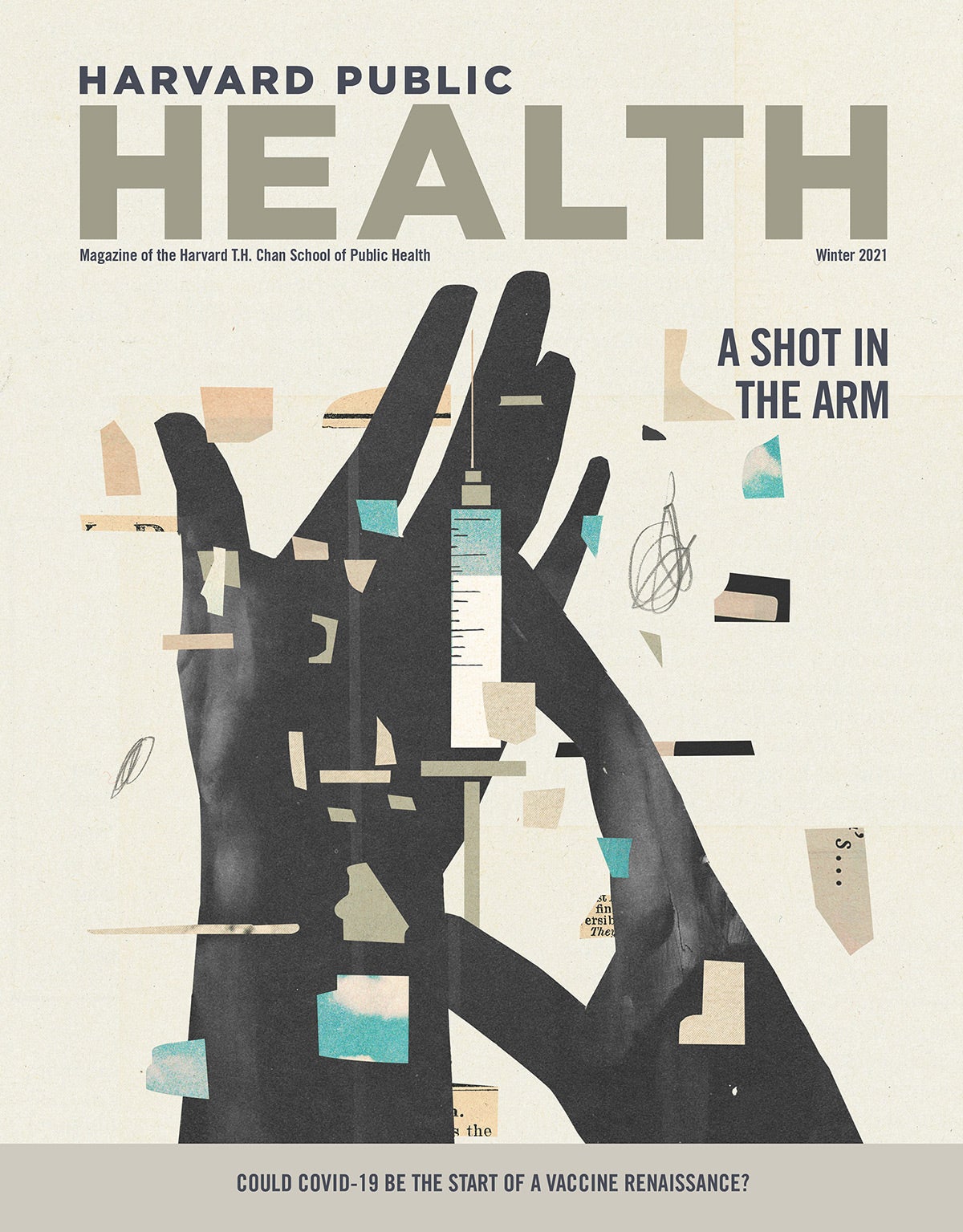Flaminia Catteruccia was in Burkina Faso collecting mosquitoes when she got an email that seemed too good to be true. Before leaving Boston for West Africa that September in 2017, she had persuaded Doug Paton, a postdoctoral research fellow in her lab, to run a few simple experiments that involved coaxing mosquitoes to land on a surface coated in atovaquone, a chemical compound used in medications that prevent and treat malaria in humans.
The experiment was a miniature moon shot. For centuries, malaria-control efforts have focused largely on killing mosquitoes. And as scientists recently learned, one of the best and most cost-effective ways to do so is by coating bed nets with long-lasting insecticides. Since the turn of the 21st century, when mass distribution of insecticide-treated bed nets kicked off, malaria cases have dropped by more than a third. According to one estimate, insecticide-treated bed nets have been responsible for 68 percent of all malaria cases averted since 2000. They are one of this century’s great public health success stories, but Catteruccia and everyone else who studies malaria knows that bed nets are no silver bullet.
Today, nearly half the world’s population is at risk for malaria. Each year, more than 200 million people become sick with it and more than 400,000 die, two-thirds of whom are children under 5. Sub-Saharan Africa shoulders the biggest share of the burden—nearly 85 percent of all cases are recorded in the region—but malaria-transmitting mosquitoes are found throughout the Southern Hemisphere, from Peru to Papua New Guinea. One of the biggest challenges to emerge in recent years is the growing number of mosquitoes resistant to the most commonly used insecticides. In some malaria hot spots, there is near-total resistance to pyrethroids, the only group of insecticides currently infused into bed nets. In November 2018, the World Health Organization (WHO) reported that the rise of insecticide resistance threatens to unravel decades of progress against mosquitoes—and the many pathogens they carry, including those that cause malaria, dengue, yellow fever, Zika virus infection, and others.
In light of this mounting threat, Catteruccia, a molecular entomologist and professor of immunology and infectious diseases, started to wonder if there was a more laser-like way of stopping the parasite without mounting an all-out assault on the insect ferrying it. After all, she says, “It’s the parasites carried by the mosquito that kill people, not the mosquito itself.”
Catteruccia reasoned that exposing mosquitoes to antimalarial medications typically used in humans might provide the same protective effect on the insect. If the mosquito didn’t become infected with the parasite, it couldn’t spread malaria. While the concept seemed straightforward, Catteruccia was well aware that administering a prophylactic drug to a frenetic animal the size of a fingernail sounded crazy. At the same time, it seemed like a no-brainer. The success of insecticide-treated bed nets made clear that mosquitoes can absorb chemical compounds through their tarsi (legs) in a relatively short time. And it was well-documented that atovaquone kills Plasmodium falciparum, the parasite that causes the most dangerous form of malaria.
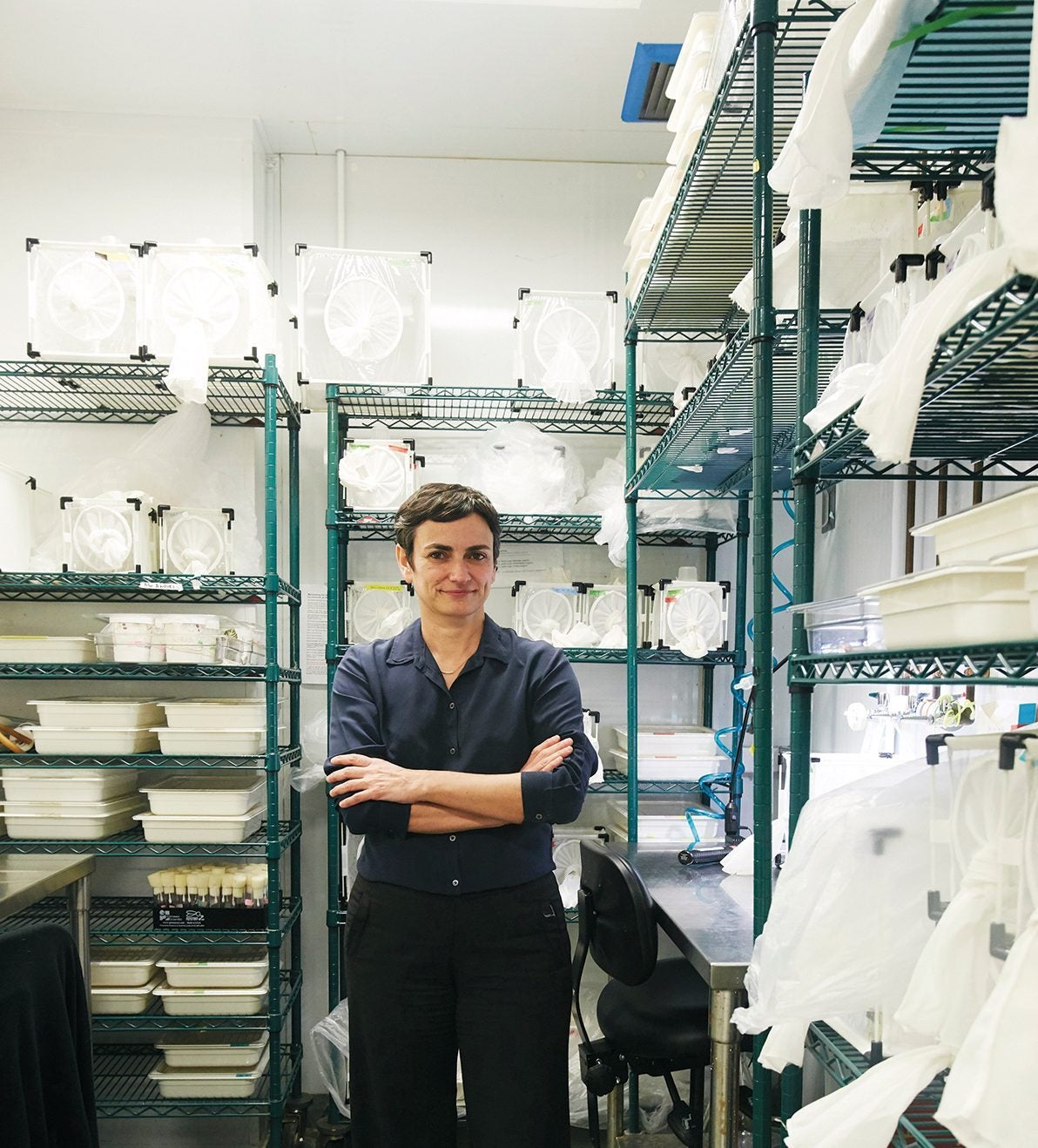
Catteruccia floated the antimalarial idea to a few colleagues and friends. “I would get blank stares,” she recalls. Some assumed that the approach had surely been tested in the past and proven ineffective. Others thought it sounded impractical. Then there was Paton, an affable postdoc from Scotland who has worked with Catteruccia for six years and estimates he has dissected tens of thousands of mosquitoes in his life—mostly to observe P. falciparum developing in the gut of the insect. Nowadays, he says, he can dissect 60 mosquito guts in a half-hour. “Fortunately,” Catteruccia says, “Doug didn’t think it was a crazy idea.”
Compact, high-spirited, with lively dark eyes and a lingering Italian accent, Catteruccia possesses the type of contagious enthusiasm that trickles down to everyone in her lab. The more she talked to Paton about drugging mosquitoes with antimalarials, the more eager he grew to test the idea. “There were a lot of hand-wavy, really excited conversations,” Paton says.
Soon enough they drew up an experiment in which they’d coat glass plates with atovaquone, set a plastic cup over them, and pipe in female Anopheles gambiae mosquitoes—one of the main drivers of malaria transmission in the world. After the mosquitoes touched down on the glass, the scientists would infect them with P. falciparum, wait a few days, and then place them under Paton’s scalpel to see whether the banana-shaped parasite was visible in the insects’ gut.
With the protocol laid out, Catteruccia jetted off to Burkina Faso, where she travels each rainy season for fieldwork. It’s a country all too familiar with the burden of malaria: According to the WHO, roughly 8 million people fell sick with the infection last year, and nearly 30,000 died. Between the slog of travel and the challenges of working in a low-resource setting, the experiment slipped to the back of her mind. Novel as the concept may have been, there were a million possible reasons for it not to work.
Then, one afternoon while she was working in a laboratory in Bobo Dioulasso—Burkina Faso’s second-largest city—her iPhone buzzed to life with an email notification. It was from Paton, and the subject line read “exciting news.” The initial test results, Paton wrote, were stunning: P. falciparum was completely absent in mosquitoes that made contact with atovaquone.
Sitting in the heavy humidity of Burkina Faso, Catteruccia was momentarily delighted. “OMG,” she wrote back. Then her well-honed scientific skepticism took over. What did Doug do wrong? she thought. We need to replicate this.
Catteruccia insists she’s not obsessed with mosquitoes, but that’s debatable. She dreams of them. She teaches her friends the morphological differences between a male and a female. And every time she squishes one that’s biting her, she “tries to preserve it just a little bit” so she can identify which genus it belongs to—Anopheles, Aedes, Culex. This has, on occasion, made for some awkward social moments. A few years back, Catteruccia was with friends in Italy when she smacked a mosquito that was biting her forearm. The insect’s guts oozed onto her skin and Catteruccia’s trained eye instantly picked up on tiny specks indicating that it was a pregnant female. She gasped, blurted out that she had killed a mom-to-be, and insisted on showing the eggs to her friends. “It was my spontaneous reaction, and the people around me were half amused and half horrified,” she says.
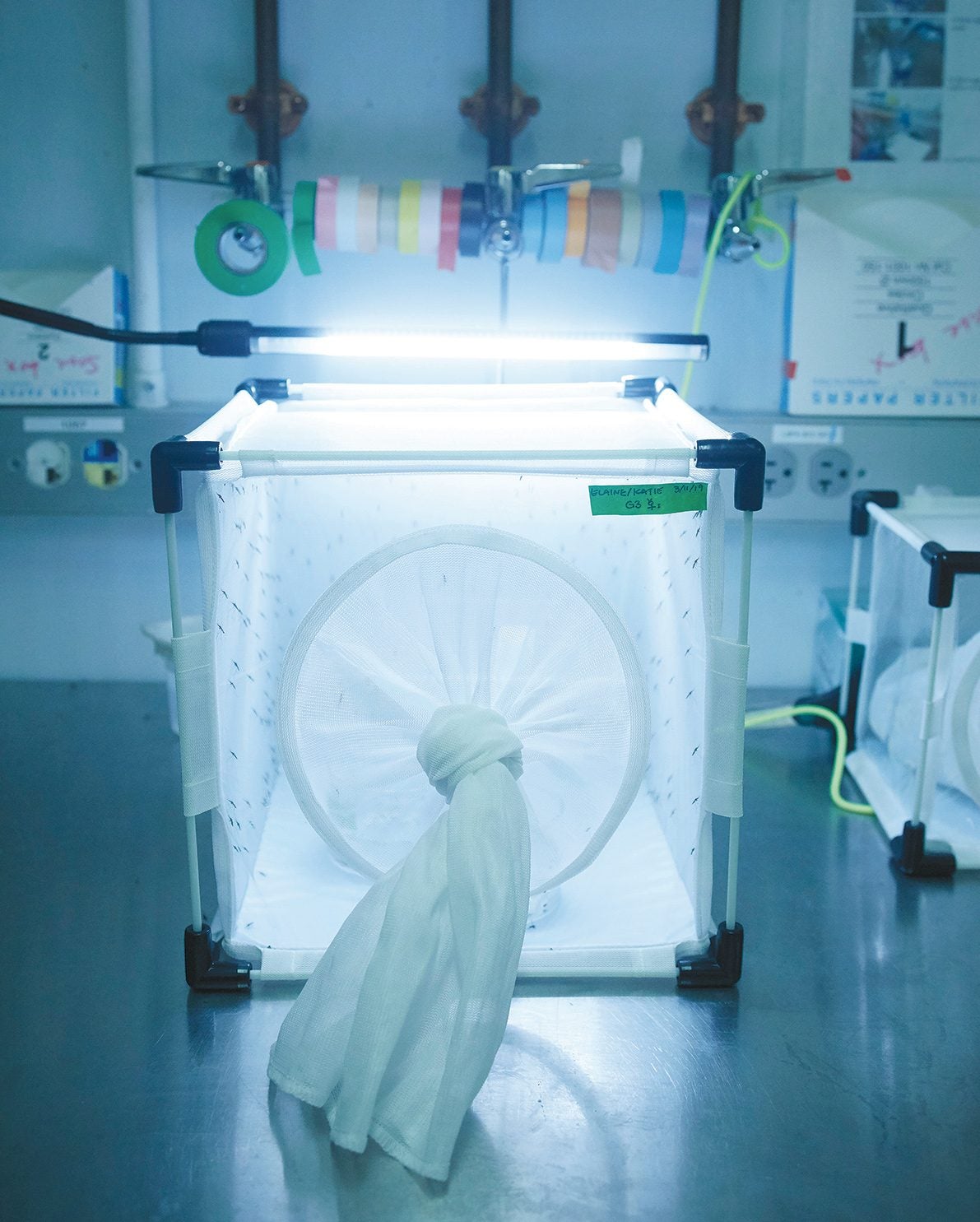
She wasn’t always this way. For most of her life, Catteruccia didn’t care about mosquitoes. She grew up in Rome, where the bugs are a seasonal nuisance, not a life-threatening menace. Nothing in her family history predisposed her to insect infatuations: Both her parents worked in publishing. Her father, a self-taught historian, started as a lift operator and worked his way up to CEO of a press that specialized in atlases. Important as education was in her household, there was no pressure to go into the sciences; one of her older sisters trained as an opera singer, the other became a doctor.
As a student at Sapienza Università di Roma in the late ’80s and early ’90s, Catteruccia majored in chemistry, because it seemed practical and interesting enough. Upon graduating, she was offered a good job with a nice salary at a pharmaceutical company. Tempting as it was, she feared that she’d be locked into a career path that didn’t excite her. Academia appealed to her, but she wasn’t ready to jump into the years-long odyssey of a doctoral student. So she applied for an entry-level technician job at a biology lab that happened to be working on mosquitoes and malaria. It was grunt work, and one of the senior researchers she’d be working with, Hans-Michael Müller, had a reputation of going through lab techs as though they were sticky notes. “On my first day, he gave me a green bucket to use when I needed ice for experiments. And on the bucket were a bunch of other people’s names that had been crossed out,” Catteruccia says. “He said, ‘This is yours. Let’s see if you can survive longer than they did.’”
The transition from studying chemistry to working in biology without any training was “quite difficult,” Catteruccia admits. She was a fast learner, though, and quickly mastered the ins and outs of extracting DNA from mosquito cells, running Western blots to analyze the proteins, and dissecting mosquito guts, which are no bigger than the head of a pin. The initially intimidating Müller turned into a nurturing mentor, and the more hours Catteruccia put in at the lab, the more she came to admire the resiliency of mosquitoes. They’ve been flying around earth for more than 100 million years, and there are at least 3,500 species known today. Only 40 of those species, all belonging to the Anopheles genus, can transmit malaria.
It’s often said that mosquitoes are the deadliest animal in the world. But as Catteruccia learned in the lab, that’s a bum rap. It’s the parasite that does the damage, and P. falciparum is among the nastiest parasites out there. After a female mosquito introduces it to a human through a bite that provides the blood that nourishes her eggs, the parasite finds its way to the victim’s liver, where it sets up shop and begins multiplying. When it reaches critical mass, it enters the bloodstream and starts killing red blood cells. The first waves of symptoms are similar to those of flu—high fevers, fatigue, sweats and chills, and brutal aches and pains. Left untreated, P. falciparum will multiply into the billions. As the victims’ red blood cells die off, their vital organs fail and they ultimately die.
After just a few months in the lab, Catteruccia was enthralled. When the research team moved from Italy to Imperial College London, she picked up and moved with it. Soon after, she entered a doctoral program in entomology. Her source of motivation, she says, is an insatiable curiosity and a borderline compulsive need to understand every minute detail of how something works. It’s an attribute that would come in handy when working on mosquitoes. “To work on an organism that affects the lives of millions of people was just so appealing,” she says.
Historically, entomologists have focused on mosquito ecology. But when Catteruccia started working on her PhD at Imperial in the late ’90s, she wanted to study the animal at the molecular level. The timing was perfect: The recent proliferation of genetic tools and sequencing technologies had opened up entirely new ways to study insects (and just about every other creature on earth), but few people were applying these novel tools to mosquitoes. By focusing on the basic biology of the insect in ways that no one else had, Catteruccia hoped to find new ways of defeating it.
In 1999, Catteruccia achieved the first genetic manipulation of Anopheles mosquitoes. It was groundbreaking: Up to that point, most genetic work on insects was restricted to Drosophila, or fruit flies. The model organism helped lay the foundation for genetic research, but it wasn’t exactly a boon for public health researchers and it didn’t translate over to mosquitoes.
“Fruit flies are super boring—they’re annoying in the kitchen and that’s about it. From a public health standpoint, they’re of no interest,” says Eric Rubin, chair of the Department of Immunology and Infectious Diseases and Irene Heinz Given Professor of Immunology and Infectious Diseases. “And it turns out that applying the methods that researchers have used on Drosophila to insects that we actually care about—including mosquitoes—is really, really difficult.”
Rubin was part of the search committee that helped hire Catteruccia in 2011, and he was bowled over by what she had accomplished in her relatively short scientific career. He knew the challenges of developing genetic techniques and tools from scratch, and he respected the fact that Catteruccia had worked through the endless logistical and safety challenges that mosquitoes present to scientists. “If you ever go into a Drosophila lab, you’ll find fruit flies all over the place. But you can’t do that with a mosquito lab. Mosquitoes are hard to grow, you have to feed them on blood, and you need an insectary or some type of containment facility because you can’t risk them getting loose,” he says. “So for Flaminia to have pioneered these procedures that have changed how mosquitoes can be studied is just amazing. And she turned out to be the perfect fit for the School.”
After heaping praise upon her, Rubin pauses for a moment, chuckles, and then adds, “Although she does seem to have a little bit of an unhealthy fascination with mosquito sex.”
It’s true. Catteruccia has probably spent more time than 99.9 percent of people on earth thinking about or observing mosquito sex. One of her favorite activities of all time is watching huge swarms of mating mosquitoes form near flooded rice fields in Burkina Faso. It’s an intricate ritual that begins at dusk with just a few male mosquitoes flying about. Slowly, more and more male mosquitoes join the fray and the swarm builds. When there are hundreds or even thousands of males buzzing around, females swoop in, find the most attractive mate, and the pair exit the swarm to engage in intimate relations. “They want some privacy—they want it to be special,” Catteruccia jokes.
The actual process of intercourse lasts no more than 20 seconds, and from that point forward the female is inseminated for her life. Feeding on blood—only female mosquitoes bite humans—allows her to develop eggs and spawn multiple generations of progeny. Over the course of an approximately three-to-four-week life, a single female mosquito can lay hundreds of eggs.
Catteruccia’s devotion to studying mosquito sex has paid off—and caught the attention of some high-profile public health advocates. Hanging on the bulletin board outside her office is a printed-out tweet from Bill Gates: “Mosquito sex is helping scientists fight malaria. Seriously,” it reads, with a link to an article about a study that Catteruccia published in Science.
That particular study examined the sexual behavior of mosquitoes in exquisite detail and analyzed 16 Anopheles genomes. It revealed that mosquitoes’ reproductive traits evolved along with their capacity to transmit P. falciparum. In other words, Anopheles species that can spread P. falciparum have distinct similarities in their sexual conquests when compared with Anopheles that don’t transmit the parasite. One of the common traits in the malaria-spreading insects is that during sex the males deliver a highly coagulated “mating plug,” a gelatinous rod-shaped bundle of ejaculate consisting of proteins, lipids, and steroid hormones. The more effective the mating plug, the less likely the female is to mate again, an indication that it may be possible to develop techniques that prevent females from mating in the first place.
Collectively, her research suggested that it may be possible to create a sort of genetic birth control for mosquitoes that could be used to suppress their population growth successively over generations. Doing so, however, isn’t going to be easy. As Catteruccia demonstrated in a paper published this spring in Cell, it’s possible to manipulate steroid hormone signaling pathways in females to reduce the number of eggs they produce, a desirable trait for mosquito control. But doing so accelerates development of P. falciparum parasites, likely because a female that produces fewer eggs has a higher investment in other metabolic functions, which opens the door for faster P. falciparum development.
“Flaminia’s work on mosquito reproductive biology and ways to negatively impact their ability to reproduce, as well as her ability to look at their reproductive capacity through changes in mating behavior, is helping us design and select new interventions for field evaluation,” says Nick Hamon, CEO of IVCC, a nonprofit based in the U.K. that focuses on stopping the transmission of insect-borne diseases. “Her research is both basic and translational at the same time, a not so common but highly valuable combination in vector biology.”
For her part, Catteruccia has embraced her status as one of the world’s leading mosquito sexperts and has found it to be a compelling way of getting people who aren’t infectious-disease researchers to think about malaria. In TED Talk–style presentations and interviews, she perfectly times her jokes about mosquito sex lasting 20 seconds and how female mosquitoes get to have sex only once in their lives. While cracking wise, she’s getting strangers intrigued about malaria and molecular genetics.
Promising as Catteruccia’s work on the reproductive biology of mosquitoes is, she knows that no single intervention will control malaria. It’s a disease in which both the vector and the parasite are crafty, resilient, and highly adaptable. What works against one species of mosquito or in one country may not work against another species or in a different setting. Stopping the spread of malaria will require an extensive arsenal of tools, including new drugs, new insecticides, and vaccines. Even then, mosquitoes will continue to forge new resistances and diminish the potency of these tools.
That’s what got Catteruccia thinking about the prospect of giving prophylactic drugs to mosquitoes. Her initial worries over postdoc Paton’s email claiming that atovaquone completely halted the formation of P. falciparum in mosquitoes were unfounded. Over the next few months, he re-ran the experiment over and over and over and arrived at the same result each time: Parasites failed to develop in the guts of mosquitoes exposed to atovaquone.
Paton and Catteruccia then began reducing the amount of atovaquone to which mosquitoes were exposed. Remarkably, they found that even when they scaled back the atovaquone concentration tenfold, the parasite was still completely stymied from reproducing in the mosquito’s gut. The scientists also tapered the chemical exposure time—from 60 minutes all the way down to six minutes, which is comparable to the time wild mosquitoes spend on insecticide-treated bed nets. The results were the same: no parasites. They tested other compounds akin to atovaquone and had similar success.
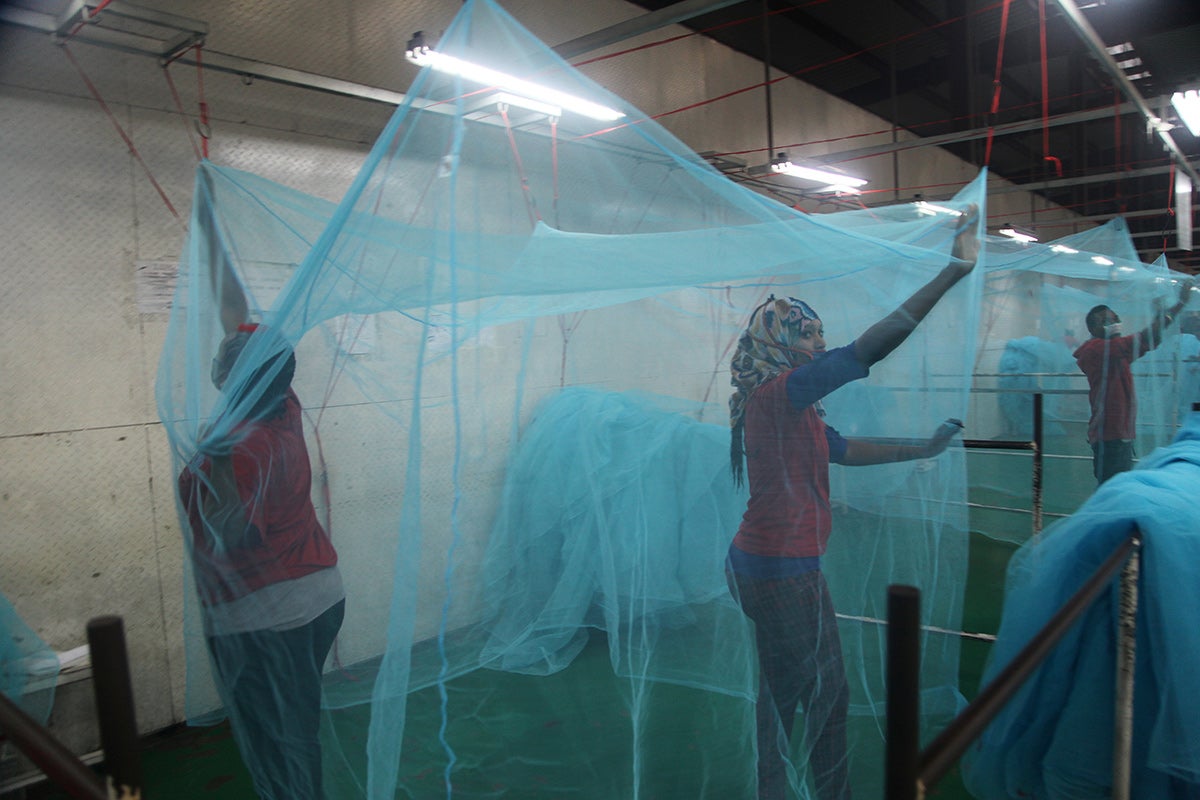
With proof of concept in hand, Catteruccia and Paton began working with researchers in the School’s Epidemiology Department to understand what type of impact coating bed nets with antimalarial drugs might have on malaria transmission. They found that supplementing conventional insecticide-treated bed nets with a compound like atovaquone could drive down malaria transmission under almost any conditions in Africa for which they had data. Perhaps even more important, the intervention would have the greatest impact in places with the highest levels of mosquito-insecticide resistance, including parts of Burkina Faso, where Catteruccia has seen firsthand the suffering the disease inflicts on men, women, and children.
In February, Catteruccia, Paton, and colleagues published their findings in Nature. Now, the prospect of antimalarial bed nets fascinates and inspires many people within the malaria community. “This is a truly novel approach in that a compound is delivered like an insecticide but it acts like a drug—curing or protecting the mosquito,” says Jeremy Burrows, vice president, head of drug discovery at Medicines for Malaria Venture, a nonprofit that focuses on developing antimalarial compounds. “One key issue is that, to protect from resistance, no approved antimalarial should ever be used in this way in the field; instead, any such compound would need to work in a different way to any used in therapy and prophylaxis. It’s an approach that the world hasn’t yet conceived, but with Flaminia’s work we can start to articulate what such a product might look like.”
Catteruccia’s discoveries represent the first step in a very long process. She is busy bringing other experts to the table to think about the obstacles ahead. Burrows, for instance, is helping to make compounds that have antimalarial properties available for testing. Finding the right compound, or combination of compounds, is critical to both mitigating the risk of drug resistance and ensuring that the parasite is effectively killed. IVCC researchers, meanwhile, are sharing insights into the properties of insecticides that work well on bed nets. The truth is that coating a glass plate with an antimalarial compound in a laboratory is far easier than saturating a diaphanous mosquito net with a chemical and deploying it over a child’s bed.
Though she doesn’t want to get ahead of herself, it’s hard for Catteruccia to suppress her excitement about these findings. They mark a new direction in malaria control, one that leverages the fruits of modern science and attempts to break away from the dominant insecticide-first, kill-mosquitoes-with-a-sledgehammer mindset in which the only good mosquito is a dead mosquito. “We’ve been really shameless in using insecticides to kill mosquitoes and other insects. For a while, there was just indiscriminate use of insecticides, which had a huge ecological impact. And we still haven’t thoroughly studied how chronic exposure to insecticides might harm human health,” she says.
Catteruccia is quick to emphasize that imperfect as insecticides are, they will remain vital to controlling malaria well into the future. For now, she’s focused on combining antimalarials with insecticides on nets. But in the long run, she thinks that coating nets, walls, and other surfaces with only antimalarial compounds could be the new norm. The approach could lead to significant reductions in human suffering and death and be better for the environment. It would also mean far fewer dead mosquitoes.
“History shows us that we’ve been trying to get rid of mosquitoes forever to stop malaria,” she says. “But maybe we don’t need to.”
Chris Sweeney is a writer and senior media relations manager at the Harvard T.H. Chan School of Public Health. He writes frequently about wildlife and environmental issues.
Listen to a podcast featuring Doug Paton:
